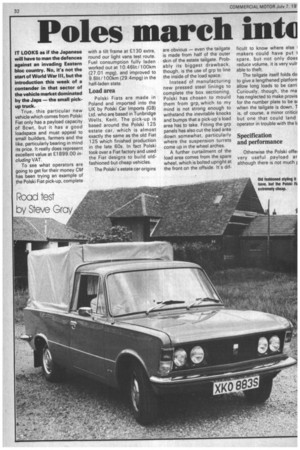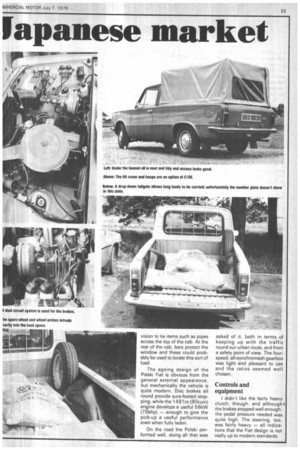Poles march ink lap anese market
Page 34

Page 35

Page 36

If you've noticed an error in this article please click here to report it so we can fix it.
IT LOOKS as if the Japanese will have to man the defences against an invading Eastern bloc country. No, it's not the start of World War III, but the introduction this week of a contender in that sector of the vehicle market dominated by the Japs — the small pickup truck.
True, this particular new vehicle which comes from Polski Fiat only has a payload capacity of 8cwt, but it has a good loadspace and must appeal to small builders, farmers and the like, particularly bearing in mind its price. It really does represent excellent value at E1899.00 including VAT.
To see what operators are going to get for their money CM has been trying an example of the Polski Fiat pick-up, complete
with a tilt frame at £130 extra, round our light vans test route. Fuel consumption fully laden worked out at 10.46Iit / 100km (27.01 mpg), and improved to 9.6Iit/ 100km (29.4mpg) in the half-laden state.
Load area
Polski Fiats are made in Poland and imported into the UK by Polski Car Imports (GB) Ltd, who are based in Tunbridge Wells, Kent. The pick-up is based around the Polski 125 estate car, which is almost exactly the same as the old Fiat 1 25 which finished production in the late 60s. In fact Polski took over a Fiat factory and used the Fiat designs to build oldfashioned but cheap vehicles.
The Polski's estate car origins
are obvious — even the tailgate is made from half of the outer skin of the estate tailgate. Probably its biggest drawback, though, is the use of grp to line the inside of the load space. Instead of manufacturing new pressed steel linings to complete the box sectioning. Polski has chosen to mould them from grp, which to my mind is not strong enough to withstand the inevitable knocks and bumps that a pick-up's load area has to take. Fitting the grp panels has also cut the load area down somewhat, particularly where the suspension turrets come up in the wheel arches.
A further curtailment of the load area comes from the spare wheel, which is bolted upright at the front on the offside. It's dif ficult to know where else makers could have put 1 spare, but not only does reduce volume, it is very vulr able to theft.
The tailgate itself folds do to give a lengthened platforrr allow long loads to be carri Curiously, though, the ma has neglected to make provis for the number plate to be s( when the tailgate is down. T is, of course, a minor critici! but one that could land operator in trouble with the
Specification and performance
Otherwise the Polski off& very useful payload ar although there is not much f
vision to tie items such as pipes across the top of the cab. At the rear of the cab, bars protect the window and these could probably be used to locate this sort of load.
The ageing design of the Polski Fiat is obvious from the general external appearance, but mechanically the vehicle is quite modern. Disc brakes all round provide sure-footed stopping, while the 1481cc (90cuin) engine develops a useful 56kW (75bhp) — enough to give the pick-up a useful performance even when fully laden.
On the road the Polski performed well, doing all that was asked of it, both in terms of keeping up with the traffic round our urban route, and from a safety point of view. The fourspeed, all-synchromesh gearbox was light and pleasant to use and the ratios seemed well chosen.
Controls and equipment
I didn't like the fairly heavy clutch, though, and although4 the brakes stopped well enough, the pedal pressure needed was quite high. The steering, too, was fairly heavy — all indications that the Fiat design is not really up to modern standards. Inside the cab, I found I was very cramped as the seat wouldn't go back as far as I needed. In fact my knees were jammed underneath the steering wheel when dipping the clutch or brake pedals. The cab itself is well equipped though, with reclining seats (which in my case I couldn't use) and a fully trimmed interior.
Around the column, the Polski has three switches, two on the left and one on the right. These operate indicators, headlamp and dip and flash, and wipers. The wipers have an intermittent facility, with a knurled knob on a panel to the right of the dash which alters the time delay. Also on this panel is the choke pull lever — connected to a flashing warning light — and a throttle control.
Instrumentation is restricted to a strip speedometer, fuel and temperature gauges and underneath these there are warning lights for oil pressure, fuel reserve, charge, handbrake, indicators and choke.
A glove box with a lid is fitted on the nebrside. Beneath it is a parcel shelf for documents and there is also a small tray beneath the heater console in the centre.
Service access
Under the bonnet all is neatly laid out, with the battery on the offside flitch plate in front of the brake servo. All service items are easily reached, including the dual master cylinder reservoirs, which are made of translucent plastics.
An under-bonnet light, controlled by a courtesy light-type switch, comes into operation when the side lights are on. The bonnet opens along the back edge and gives good all-round access. To increase the Polski's longevity, all box sections are treated with anti-corrosive material.
Summing up
If an operator doesn't mind the outdated styling, there is no doubt that the Polski Fiat offers remarkable value for money. Our test vehicle was very well finished, both in terms of overall presentation and of paint work. It is well equipped — to the extent of having warning lights in the ends of the doors — comfortable for averaged sized drivers and very quick around town. I think that the Japs had better be on their guard, as this Polski vehicle has a lot going for • it. The price as tested was £2,020.
























































































































































